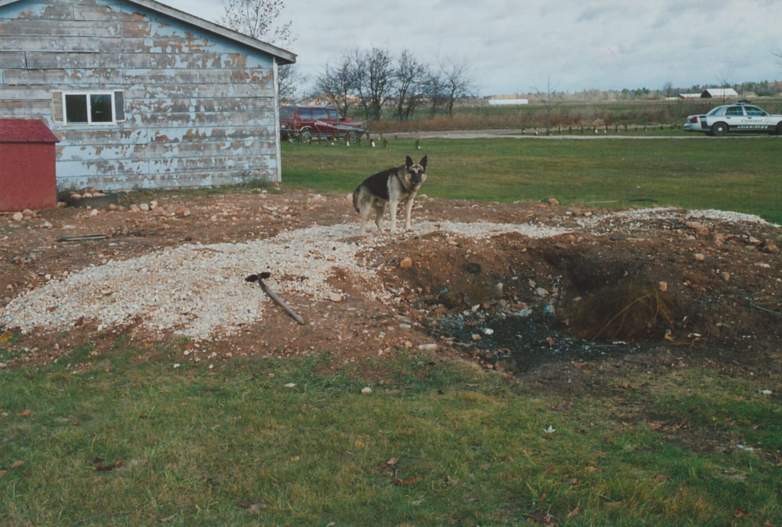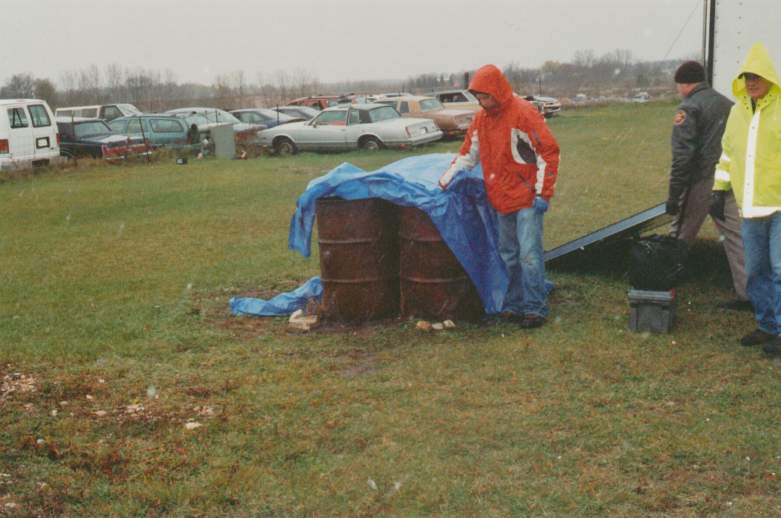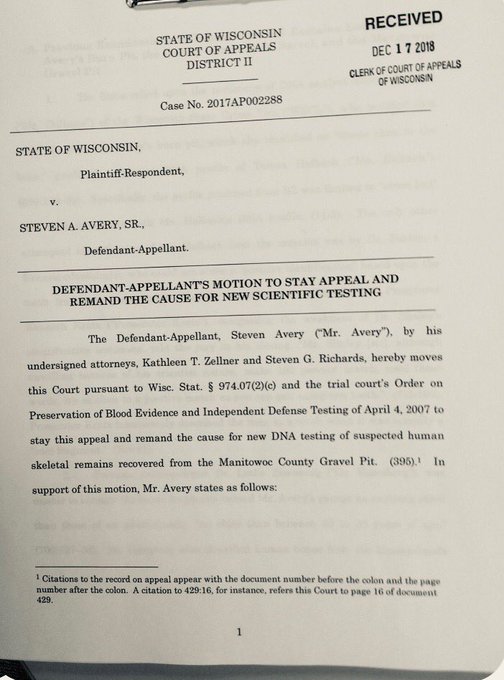
Getty Kathleen Zellner initially turned down Steven Avery's case before watching Making a Murderer.
Richard Selden, a DNA expert, is “willing to test the bones” found in a Manitowoc County gravel pit to see whether it can be determined once and for all whether the fragments belonged to murder victim Teresa Halbach.
That was the latest salvo from attorney Kathleen Zellner, who is representing Steven Avery, the Wisconsin man who was convicted of Halbach’s murder with his then-teenage nephew, Brendan Dassey. The case was featured in two seasons of Making a Murderer on Netflix; season 2 featured the efforts by Zellner – and lawyers for Dassey – to win on appeal. The lawyers allege that the men did not slay Halbach, a young photographer who had come to the Avery family salvage yard that day to take pictures of a van for a magazine.
“We are pleased to announce that one of the world’s leading DNA experts, Dr. Richard Selden @drrichardselden, is willing to test the bones in the Manitowoc County Gravel Pit with new Rapid DNA ID. If this testing is allowed, we believe the bones will be Ms. Halbach’s,” Zellner wrote on Twitter on December 17, 2018. Zellner’s other attempts to win a new trial for Steven Avery have been to no avail.
Zellner is now asking for new DNA testing:
Wisconsin court records confirm that Zellner filed a motion “of appeal and remand …for new scientific testing.”
In other news in the case, now retired Wisconsin law enforcment officer Andrew Colborn filed a lawsuit on December 17, 2018 against Netflix and the Making a Murderer documentarians. “Overwhelming physical and circumstantial evidence proves that Steven Avery and his sixteen year old nephew, Brendan Dassey, were the perpetrators of the crime. Neither plaintiff nor any other law enforcement officer planted evidence or in any other way attempted to frame Avery or Dassey for Halbach’s murder. Separate juries returned guilty verdicts against each of them in 2007, and their convictions remain unreversed after numerous appeals,” it reads. You can read Colborn’s lawsuit in full here. The lawsuit claims that “Material and significant facts known to the defendants were omitted and distorted.”
Here’s what you need to know:
Zellner Argues the Gravel Pit Bones Will Show Avery Was Framed

Wisconsin prison systemSteven Avery today
As she has done before, Kathleen Zellner fielded questions on Twitter from viewers. This time, she focused on the bones. She added on Twitter, “This will prove the murder and mutilation occurred in the Manitowoc County Gravel Pit and the bones were planted in Mr. Avery’s burn pit to frame him.”
She added, “This was evidence the State used to convict Steven Avery of the murder. The State defines what is relevant to the conviction and we attempt to refute it. #askzellner.” At the time of Avery’s trial, she wrote, “the technology did not exist, and the FBI was unable to test the bones because of their degraded condition in 2006. #AskZellner.” She said she believes 99% that the bones are Halbach’s.

Manitowoc CourtsIn this Steven Avery crime scene photo, you see a burn pit behind his trailer. That’s where authorities say they found some of Teresa Halbach’s dental and teeth fragments.
In Making a Murderer 2, Zellner argued that Halbach was probably not killed on the salvage yard – as the prosecution contended at trial – but rather that she was murdered off the property and then her remains were removed back on it (burnt fragments of Halbach’s teeth, bones, and belongings were found in a burn pit and barrel near Avery’s house on the junkyard property). At trial, bone fragments found in an adjacent quarry were discussed before the jury, but a state expert testified she couldn’t be sure whether they were human or not but said they might be human.
If the bones in the gravel pit were proven to be Halbach’s, it would blow a hole into the state’s narrative at trial as to how the murder occurred, which could be even better news for Dassey than for Avery because Dassey’s conviction was largely based on a confession he gave as a juvenile asserting that he and his uncle murdered Halbach in Avery’s trailer. Dassey’s attorneys (and, previously, a federal magistrate judge and appellate court panel) argued the confession was wrongfully obtained but the full appellate court disagreed and upheld Dassey’s conviction. Both men are still in Wisconsin prisons today.
“It refutes the State’s case that the murder occurred in the garage and the burning occurred in the burn pit. Our job is to deal with the evidence that was presented, not what somebody dreams up 13 years later,” Zellner wrote. Of course, the state could still contend that Avery murdered Halbach off site and moved her bones to the salvage yard property, but that’s not what they argued at trial.
“Brendan’s confession was coerced. Why would Steven bring bones from the gravel pit and then bring them back to his burn pit? Why would he bring any bones to or from the gravel pit?” wrote Zellner. Of the new technology, she wrote, “Yes, it just obtained FBI approval and has been successfully used to identify California wild fire burn victims.”
Zellner also answered questions from viewers via her Twitter page on December 17. Here are some of the comments she made:
“State’s theory is based on LOCATION of evidence & link to SA so 1) Bullet is in SA’s garage 2) Bones in SA’s burn pit 3) Key in SA’s trailer 4) Phone etc. in SA burn barrel 5) RAV4 on SA property. State fought idea of TH bones in MCGP or Rav off ASY #MakingAMurderer2 #DNARules.”
“We discovered there were 3 bone piles in MCGP not just 1 & they all have human bone in them. @lifeafterten @michellemalkin @newsweek @johnferak #RecklessInvestigation #MakingAMurderer2.”
“(Former prosecutor Ken) Kratz said that because it couldn’t be shown the bones were human that he wasn’t going to spend 20 seconds on them. We believe that identifying the bones as Ms. Halbach’s will cause the case to be reversed for a new trial.”
“The attorney general had agreed to a microscopic examination of the bones in 2017, so we know that they realize that the identity of the bones is important.”
“That’s the purpose of the new DNA testing. The State’s forensic anthropologist opined that some of the gravel pit bones were human and some were suspected human.”
“The court can order the release of the bones for DNA testing.”
“…Rapid DNA ID now has authorization to be entered into CODIS. It will revolutionize DNA testing in the United States.”
“The bones were sent to the FBI and they were unable to test them because of their degraded condition. So, he recognized they identity of the bones was important evidence.”
Richard Selden Founded a Company That Provides ‘Rapid DNA’ Services

Richard Selden websiteRichard Selden
According to his website, Dr. Richard Selden “is the Founder, Chairman, and Chief Scientific Officer of ANDE. The leading provider of Rapid DNA Identification products and services, ANDE serves a clientele spanning the law enforcement, military, and homeland security communities of the United States and its allies. Since founding ANDE in 2004, Dr. Richard Selden has steadily worked to position the Company as a trusted provider to enable Rapid DNA Identification to be implemented broadly to enhance societal safety.”
His bio adds, “Dr. Selden received his BA degree from Harvard College, MA and PhD degrees in Genetics from the Harvard Graduate School of Arts and Sciences, and MD from Harvard Medical School. He trained as a pediatrician at the Children’s Service of the Massachusetts General Hospital. Over the years Dr. Richard Selden has held numerous academic appointments. As an undergraduate and graduate student, he served as a teaching fellow, conference leader, and lecturer on biochemistry, biology, and cell biology at Harvard College, Northeastern University, and Roxbury Community College.”
Selden has taught at Harvard Medical School. “For three years, he was appointed an Instructor in Pediatrics at Harvard Medical School. Additionally, Dr. Selden has lent his expertise to numerous industry committees. He was part of the Committee on Research Review for the American Diabetes Association for three years and also served on the Curriculum Committee for the Harvard-M.I.T. Department of Health Sciences and Technology. He has also served on Massachusetts Conservation and Community Preservation Commissions,” his bio reads.
The Bones Came Up During Avery’s Trial

Bone fragments were found in the burn pit behind Steven Avery’s garage on November 8, 2005– three days after Halbach’s car was found on the lot.
Leslie Eisenberg, a state expert, was program coordinator for the state of Wisconsin’s burial sites preservation program for the Wisconsin Historical Society and one of only 75 board certified forensic anthropologists in the country when she testified for the state in the Avery trial. She helped identify fragmentary human and non-human remains after Sept. 11. After Katrina, she helped identify victims and skeletonized human remains that washed out of cemeteries. The defense attorneys highlighted the fact that only 40 percent of Halbach’s bones were found.
This showed, they said, that the real killer had burned Teresa elsewhere, and then dumped only some of the bones – sprinkled them throughout the backyard – to frame Avery, although it’s possible the rest of the bones just burned. Bones were also found in two locations: In what was called the Janda burn barrel and a burn pit behind Avery’s trailer. Those were both behind Avery’s trailer, though, about 20 feet from his door.
The barrel known as the Janda burn barrel contained the spine, shoulder blade, leg bones and arm bones. Eisenberg testified that she thought the “primary burn site” was behind Avery’s garage, in the burn pit, though, not in the Janda barrel and not somewhere else, court records show. Asked whether the bones could have been moved to the burn pit, she said she would have seen breakage but didn’t.
“Based on the volume of human bone fragments behind the garage, I find it highly unlikely, um, that that was not the primary burn location,” she testified.
Eisenberg didn’t recover an entire bone from the burn pit but said “at least a fragment or more of almost every bone below the neck was recovered in that burn pit.”
Eisenberg was also asked to look at a mysterious evidence packet with the tag number 8675. The plastic lidded container bore small bone fragments recovered from one of the quarry pits southwest of Avery’s property. These are the bones Zellner now wants tested.
“There were several other bones whose origin, I could not be sure of. In other words, I was not sure that the bones were definitely human,” Eisenberg said at trial.
She identified a bone she suspected of being from the “iliac crest” – two fragments that appeared to be pelvic bones. Bone was burnt to the point of being “calcined.” She said these bones showed evidence of cut marks and a saw cut. They were too fragile to “survive tests” to determine whether they were animal or human.
When the defense attorney asked Eisenberg, “Now you suspected them of being human pelvic bone, am I understanding you correctly?” She said yes, and called them “Suspected possible human.” She said the measurement of bone in humans is less than that of a deer bone, which is why she suspected they might be human. She said the features she was seeing were “consistent with an adult female human skeleton.” But she couldn’t say for sure.
The evidence packet with Tag 8675 contained a total of 13 bone fragments. Some of those, Eisenberg was able to determine, were nonhuman unburned bones. However, eight fragments were burned. Ten fragments had cut marks. The charring and calcined condition of the burned fragments was similar to the human bone fragments in the Janda burn barrel and behind Avery’s garage, Eisenberg said.
Of the eight burned bone fragments that showed suspected cut marks, one was definitely non-human, she added. That meant that some non-human bones were also burned, in addition to the ones that could be human. In the end, only three fragments “could be human,” testified Eisenberg, according to court transcripts.

Manitowoc CountyThis is a crime scene photo of one of the burn barrels on the Avery property.
Still, Eisenberg insisted, the most probable primary burn site was the area behind Steven Avery’s garage. She couldn’t rule out another burn site, but she said the “overwhelming majority of fragments” were in the burn pit behind Avery’s trailer. Furthermore, she found most of the small, delicate brittle fragments there, such as facial bones. If those bones had been moved to the burn pit from somewhere else, she would expect to find breakage and didn’t (the defense pointed out that investigators used shovels to move the debris for sifting and sorting and didn’t cause breakage with that).
In his closing argument, Jerome Buting, the defense attorney at trial, said, “These bones were moved.” He said the prosecution had “no explanation for why bones, human bones would be found in the Janda burn barrel some 15 feet away” from the burn pit.
Buting maintained there was a “third site. There’s actually three different sites where human or possible… human bones were found. Clearly identified human bones were found in the burn pit and clearly undisputed human bones were found in the burn barrel but there’s also this mysterious quarry site a quarter mile or so away…”
Buting noted the quarry pit fragments “were all burned to the same degree with the same amount of calcination.” And he said much was unknown about them.
“You have never seen a photograph of what this site looks like or what the bones looked like and neither have I,” said Buting. “Eisenberg admitted that by the time she got the bones, she was unable to determine some important information about its location, how it was sited and not only was nobody called to the scene, but no photographs.”
The defense also called its own expert, who found serious problems with how the bones were collected overall. Buting suggested to the jury that “somebody else burned Teresa Halbach’s body elsewhere, maybe in the quarry, maybe somewhere else… they used that burn barrel that was found on the Janda property as a container to transport the remains, as many as they could scoop into Mr. Avery’s backyard. And they dump it in the burn pit or scatter it about, and they inadvertently leave a few behind. This is most likely happening in the dark.”
Dr. Scott Fairgrieve, the defense expert, was chair of the Department of Forensic Science at Laurentian University in Ontario.He didn’t think the bone fragment collecting was well done. “The documentation with the photography was fairly poor,” said Fairgrieve. It was difficult to tell the original location where bones fell. Investigators had not imposed a grid system when first processing the evidence, which would have allowed scientists to determine the bones’ positioning, he said. Instead, they used shovels.
He could not agree that the primary burn site was in the burn pit behind Avery’s garage because “the documentation itself did not lend itself to interpretation,” court records show.

Comments
Expert Richard Selden Would Test Steven Avery Case Bones